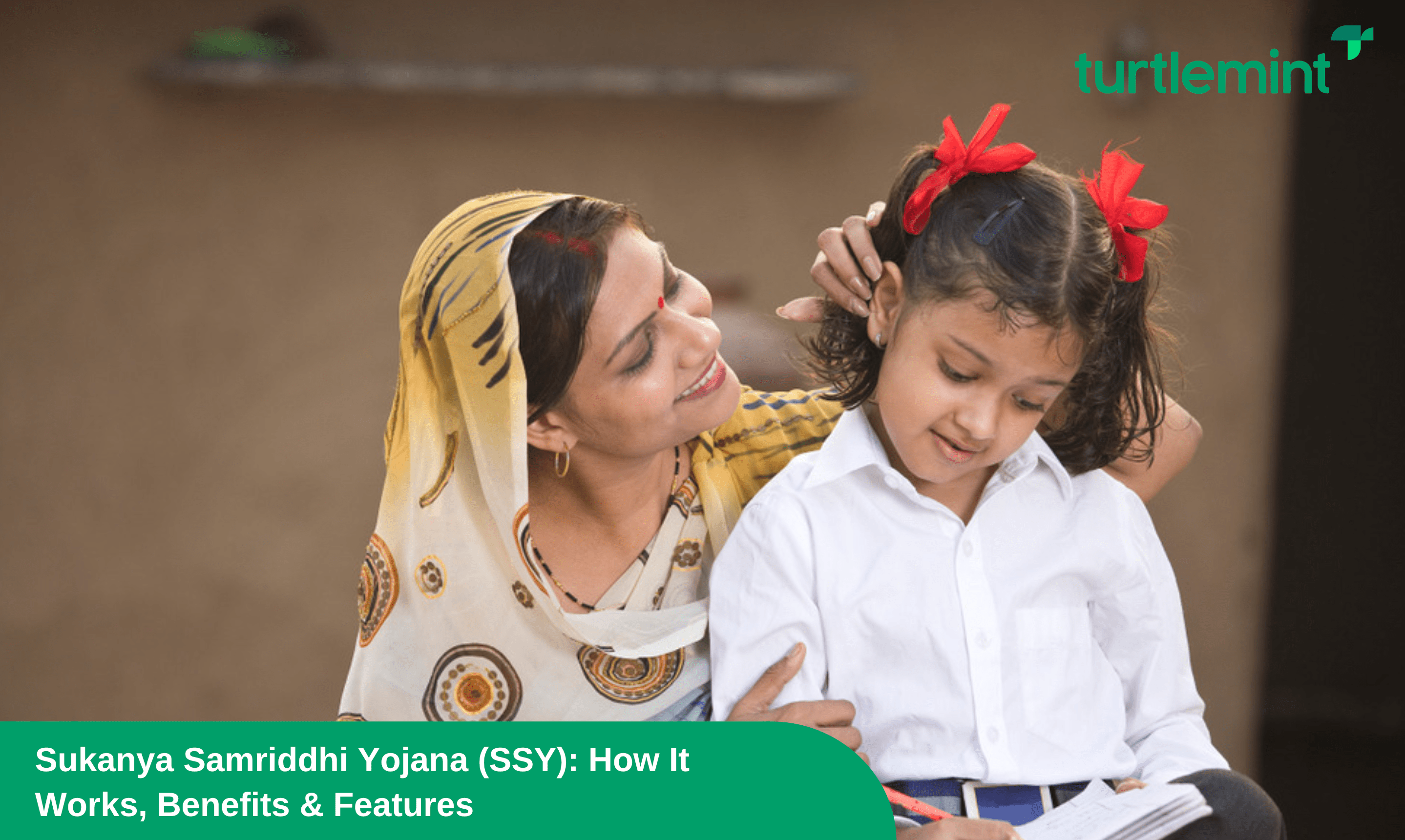
Though the evil of gender discrimination still exists in India, things are changing slowly yet steadily. With girls competing in just about every field, be it academics, sports, or competitive fields. The societal role of girls is evolving. From time to time, the government also takes initiatives to uplift the status of girls and women. The “Beti Bachao aur Beti Padhao” campaign has been aggressively encouraged to abolish discrimination against girls. Sukanya Samriddhi Yojana plan is one such highly-applauded initiative by Prime Minister Narendra Modi for the welfare of the girl child.
The scheme gives an investment opportunity to the parents of the girl child under the age of 10 years for their education and marriage finances. The program offers a doorway for every girl in the country to access education without financial constraints.
Sukanya Samriddhi Yojana benefits and features
Along with educational and marriage financing, the Sukanya Samriddhi Yojana plan has many other advantages making it one of the best investment schemes for the female child.
- Sukanya Samriddhi Yojana scheme is a small savings-based government scheme initiated in 2015 and the Beti Bachao, Beti Padhao Yojana campaigns.
- The scheme aims to protect and save the future of girl children by providing financial support.
- Parents or guardians can start investing in the Sukanya Samriddhi Yojana plan on behalf of their girl child and save money for her future.
- You can withdraw 50 % of the SSY account balance for higher education or school fees by submitting the educational organisation admission proof to cover the maximum education financing burden.
- Affordable monthly investment, with a minimum deposit of INR 250
- You can also enjoy tax exemption benefits on the amount received at the maturity under section 80 C of the Income Tax Act
- Competitive interest rates, compared to other government investment schemes, the Sukanya Yojana has a high return interest rate of 7.6% p.a.
- Flexible instalments, pay whenever you want and any amount according to your convivence
- Available at any every government bank and post office near your home
- Anyone with a girl child under 10 years of age can apply for the scheme
- The scheme is suitable for people from every walk of society.
- The deposits accumulate along with high-interest rates and can be withdrawn fully after 21 years or partially once the child turns 18 years.
Key Highlights Of Sukanya Samriddhi Yojana Scheme
|
Interest rates |
7.6% interest per annum |
|
Minimum deposit per annum |
Rs. 250 per year If no deposits are made during a financial year, the accounts become default or dormant. To activate the account, a penalty of Rs.50 must be paid. |
|
Maximum deposit per annum |
INR 1,50,000. |
|
Maturity span |
Tenure period extends for 21 years or until the girl child is 18 or married. However, deposits are required only until the first 15 years. |
|
Eligibility criteria |
Girl child 10 years or younger. Only two SSY plans are allotted for one family. Exceptions are given when twins or triplets of girls are born in the same family. |
|
Tax benefits |
|
Interest rates offered by Sukanya Samriddhi Yojana:
To provide the maximum benefits for the girl child in terms of financial and educational benefits, the government allocates high-interest rates for the SSY scheme.
- Government usually assigns the interest rates every quarter of the annum
- When it was introduced in 2015 the government gave an interest of 9.2% per annum
- As of the financial year 2022 – 2023, the interest rates are 7.6% per annum
- Regarding interest on the ‘Account under default’ accounts (those accounts where no minimal deposits were made during the entire financial year) the interest is added using the post saving accounts. However, this doesn’t apply when the guardian who opened the account is dead.
Calculation of Sukanya Samriddhi Yojana interest
To understand the Sukanya Yojana benefits, it is important to understand the calculation of the Sukanya Samriddhi Yojana’s interest. With a fixed return of 7.6%, let’s see how the maturity amount can be calculated. The formula to calculate the amount is:
|
Amount = P(1+r/n)^nt |
Here,
- A stands for the Compound Interest
- P stands for the Principal Amount
- n is the number of times the interest is compounded in one year
- t is the number of years
- r stands for the rate of interest.
Sukanya Samriddhi Yojana Calculator
The manual calculations may be cumbersome and quite time-consuming. However, if you wish to get an idea of the variable or the maturity amount, the best way to do so is through the Sukanya Samriddhi Yojana calculator. This free online tool comes in very handy and helps you plan ahead.
You simply need to feed in the following details:
- The yearly investment you wish to make
- The age of the girl child
- The starting date/ period of the plan
In a matter of seconds, the calculator will show you:
- The total investment that you will make
- The tidal interest that you will earn
- The year of maturity of the scheme
- The total maturity value
The calculator will give you an error-free output and you can use it changing the variables time and again. The online tool works efficiently on all kinds of devices.
Working of Sukanya Samriddhi Yojana Account
Sukanya Samriddhi Yojana is a long-term scheme where a deposit of a minimum of INR 250 and a maximum of INR 1.5 lakhs can be made in a year. The tenure of the scheme is 21 years and it can be purchased for a girl child who is aged 10 years or less. Lets us take this example:
Rajiv and Sonali Mishra were recently blessed with a baby girl. They invested in the Sukanya Samriddhi Yojana when their daughter Megha was just a few months old. Till Megha turns 15, Rajiv will make a monthly/ annual deposit in the SSY. The money can, however, be withdrawn once Megha turns 21. It is for Rajiv to decide if he wants to pay after Megha turns 15, as the 15 to 21 years span requires only voluntary contributions. Once Megha turns 21 they can withdraw the entire amount.
There are also certain circumstances, where partial withdrawals can be made. We will discuss them ahead.
Let us take another scenario. If Rajiv and Sonali invested in the Sukanya Yojana, after Megha turned 5, then the plan would mature only when she completes the age of 26. Rajiv would have to make the contribution till she turns 20, and for the next 7 years, if he wishes to.
Withdrawal rules of Sukanya Samriddhi Yojana
On the maturity of the Sukanya Samriddhi Yojana scheme, the policyholder will get the amount directly to her bank account. But, in case of premature withdrawal, the deposit amount can be withdrawn before maturity only after five years of opening the account. Also, to claim a sum before maturity, you need to meet some criteria, let us take a look:
- If you need money for your daughter’s higher education you can withdraw 50% of the account balance till the last financial year
- You can make a partial withdrawal if you are planning your daughter’s wedding
You can opt for premature closure of the Sukanya Samriddhi Yojana in the following circumstances:
- Death of the girl child
- Death of the guardian of the girl child
- The girl child becomes a citizen of another country
- The policyholder is suffering from a life-threatening disease.
Eligibility criteria for Sukanya Samriddhi Yojana
To apply for Sukanya Samriddhi Yojana, there are a set of eligibility criteria for the girl child and the parent.
- The girl child must not be older than ten years of age. Even though a one-year grace period of 1 year is offered, the parent can apply for the scheme before the girl turns 11.
- It is imperative that the person opening and operating the account on behalf of the girl child can be her biological father or her legal guardian.
Documents required to open a Sukanya Samriddhi account:
To open a Sukanya Samridhhi account, you need to submit a set of documents for verification and authentication of the information filled in the application form.
- Account opening application form
- Birth Certificate of the girl child, as the age proof
- Photocopies of the parent or the legal guardian
- KYC documents for ID and address proof
- PAN card
- Driving Licence
- Passport
- Voter ID Card of the parent/legal guardian
- Job Card signed by a government authority
- Adhaar Card.
Steps to open a Sukanya Samriddhi Yojana account:
Adults can collect the Sukanya Samriddhi Yojana scheme application form from the post office or any registered bank. They can also download the applications directly from the online portals. The adult is expected to fill the form with details needed and submit it back along with the reference proof documents. These include
- Name of the account holder or the child’s name
- Name of the joint account holder or the name of the parent (or the guardian)
- Child’s birth certificate
- Identity proof of the parent’s or the guardian’s (like passport, Aadhaar card, driving license etc)
- Details about the present and permanent address along with its proofs
- Details about the child’s medical history
- Mentioning the initial deposit amount and its details like cheque or DD number and date.
Steps to fill Sukanya Samriddhi Yojana account form for the post office:
To open a Sukanya Samriddhi account, you can visit any authorised bank or post office branch associated with this scheme. Here are the steps you might have to follow when you apply in person.
- Collect the application form from the authorised bank or post office.
- Fill and submit the form with necessary details like the name of the child, name of the guardian or parent, address and contact information.
- You must also submit the supporting ID and address proofs
- Deposit the first investment amount of Rs.250 up to Rs.1.5 lakhs to open the account
- Once the details and funding are approved, the bank or the post office will activate your SSY account
- Once you receive the passbook for the account, you can continue the scheme for the next 21 years.
How to make payment for Sukanya Samriddhi Yojana online?
To open a Sukanya Samriddhi account online, you must install the India Post Payments Bank (IPPB) application on your smartphone. Using this application, you can open and maintain your SSY accounts.
- Download the IPPB app
- Transfer funds from your bank accounts to the IPPB account
- Open DOP products and click the Sukanya Samriddhi Yojana plan
- Fill in the SSY account details and DOP user ID
- Choose the instalment duration and investment amount
- The app will inform you once the account is opened.
- You can use the same application to deposit the funds every year.
Investment frequency under Sukanya Samriddhi Yojana :
You can either choose to deposit once a year or in instalments throughout the year. But, the minimum annual amount that you must deposit is INR 250. To keep the account active, you must deposit the minimum amount every year for 15 years. Payment intervals between instalments are flexible, and you can pay whenever you want. Furthermore, there is no limit to how many instalments you can make per year.
Sukanya Samriddhi Yojana Details in the passbook
When you open a Sukanya Samridhhi Yojana account you get a passbook. There are no extra fees for the passbook. However, you should carry the passbook with you for depositing your regular or annual instalments at the bank. It is also necessary to submit the passbook at the time of account closure. Furthermore, make sure you update your passbook regularly to record every update of your SSY account.
List of banks offering Sukanya Samriddhi Yojana
Sukanya Samriddhi Yojana plan can be availed from most government and private sector banks in India. It is also available at local post offices, making the scheme available even in remote and rural areas. You can also apply for the Sukanya Samriddhi Yojana online. Check out this list to know banks that offer the Sukanya Samriddhi Yojana.
- Punjab National Bank
- ICICI bank
- Axis Bank
- Bank of Maharashtra
- Dena Bank
- Vijaya Bank
- IDBI Bank
- Bank of Baroda
- Bank of India
- Canara Bank
- Allahabad Bank
- Indian Bank
- Punjab and Sind Bank
- UCO Bank
- State bank of India
- Central Bank of India.
Difference between PPF & Sukanya Samriddhi Yojana, and which one is better?
When planning your investments, it is only prudent that you compare the options in detail before committing for the long term. While both the Public Provident Fund and Sukanya Samridhi Yojana are government-initiated, there are many differences in their features as well as the outcome. SSY is basically a welfare scheme for the girl child whereas the PPF allows the investor to earn tax-free interest. Let us take a look at their differences and then analyse their benefits:
|
Public Provident Fund |
Parameters |
Sukanya Samridhi Yojana |
|
7.10% |
Rate of Interest |
7.60% |
|
Minimum: INR 500 Maximum: INR 1.5 lakhs |
Annual Deposit |
Minimum: INR 250 Maximum: INR 1.5 lakhs |
|
Up to INR 1.5 lakhs |
Tax Savings |
Up to INR 1.5 lakhs |
|
15 years |
Term of the Policy |
21 years |
|
Partial withdrawal can be made after 15 years |
Withdrawal |
Partial withdrawal can be made after 21 years |
|
Loan facility is available |
Loan |
Loan facility is not available |
|
Available |
Nomination |
Not available |
Now that you know the differences between the Public Provident Fund and Sukanya Samridhi Yojana, you would be in a better position to plan your finances. While the interest rates may seem quite similar, long-term investment can bring a lot of difference to the final corpus. Keep the pros and cons of both in mind when you compare them and make a well-informed decision.
Difference between Children’s Mutual Funds & Sukanya Samriddhi Yojana:
When it comes to planning for your child’s future, you would always want to make the best decision. With the rising costs of education, it is imperative that you start saving at the right stage. Investing in Children’s Mutual Funds or Sukanya Samriddhi Yojana can be a recurring question in your mind. Let us take a look at their key differences:
|
Sukanya Samridhi Yojana |
Parameters |
Children’s Mutual Funds |
|
SSY can only be opened for a girl child by a parent/ guardian |
Account Opening |
Parents can start investing in their child’s name |
|
Done by parents/ guardian till the child turns 18, thereafter the child can assume control |
Management of Account |
Managed by the parents. Children’s mutual funds come with a 5-year lock-in period or till the child turns 18 |
|
Account can be opened only till the child is 10 years or below |
Age Criteria |
This kind of mutual fund can be opened for a child under 18 years |
Sukanya Samriddhi Yojana is a government-backed scheme that offers you guaranteed returns. Children’s mutual funds on the other hand may seem lucrative because of the high returns they offer, but the element of risk cannot be ignored. So, what should you choose in such a scenario?
While Sukanya Samriddhi Yojana is an excellent saving scheme, it may not be entirely sufficient keeping in mind the unabated increase in the cost of higher education. Financial experts advise that you follow a more balanced approach and invest in both these options. You have the security and tax-saving benefits of Sukanya Samriddhi Yojana, while Children Mutual Funds can offer you better returns.
Steps to download the Sukanya Samriddhi Yojana statement
You can download the Sukanya Samriddhi Yojana statement from the bank’s online portals. However, all banks don’t provide these services. If the bank your SSy account is linked with allows you to download statements, then request the bank executives regarding the online account login details like the login ID and password.
- Using the account details, log in to the SSY account from the online portals of the bank.
- The dashboard or the homepage will provide you with your account statements
- Download the details from the same page.
What happens upon less/excess payment for Sukanya Samriddhi Yojana account
- Less than the minimum deposit
When the account holder doesn’t pay the minimum value of Rs.250 within a financial year, then the account becomes a ‘default account’. In order to activate the account, the account holder must pay an additional INR 50 as a penalty. - Excess the maximum deposit
When the deposits made are over INR 1.5 lakhs then no interest will be included in the additional money deposited. You can withdraw the excess funds anytime you want.
How to transfer an SSY account?
You can transfer the SSY account from one branch to another within the country. Here are the steps you need to follow during the process
- Visit the post office or the bank where you have opened your existing SSY account and request the transfer application
- Fill in the details of the new branch you are planning to transfer the funds and submit it along with the passbook for approval.
- Once approved, the bank will close the existing account and give the customer their bank statements and other details regarding the existing account.
- You must submit these documents to the new branch where you will transfer the account.
- While opening the account in the new post office or bank, you must also submit additional KYC documents for further verification.
Conclusion
The SSY aims to uplift the lives of the girl child in India. With the Sukanya Samriddhi Yojana benefits like tax reduction and high-interest rates, the girl child is secured with financial support over its tenure phase of 21 years.
Easy application and minimal investment options make these schemes viable for an average household. Joining the scheme can be the next best thing you can do to financially secure the future of your daughter.
FAQs
- What is the online payment method for the Sukanya Samriddhi Yojana?
SSY payment instalments can only be made online if you have IBPP installed on your smartphone.
- Visit the IBPP app, navigate to the DOP products section and click on the Sukanya Samridhhi Yojana
- Enter your DOP customer ID and SSY account number
- Make the payment of the amount you wish to deposit
- How many accounts can be opened in Sukanya Samriddhi Yojana?
Only one account can be opened for a female child. Also, only two girl children from a family can opt for Sukanya Samridhhi Yojana. But in the case of twins or triplets girls, more can two accounts can be opened.
What are the steps to open the Sukanya Samriddhi Yojana account at the post office?
To open a Sukanya Samriddhi Yojana account, you need to:- Visit your nearest Post Office
- Fill in an application form and submit the required documents along with it
- Pay the minimum deposit fee
- The post office will check the form and approve your application
- After approval, your account will be opened
- What is the Sukanya Samriddhi yojana transfer procedure?
In order to transfer the account, follow the steps given below:
- Visit the Post Office or Bank in which you have your SSY account
- You will need to fill in the account transfer form, submit the required KYC documents
- The bank/post office will verify and send the original KYC documents to the bank/post office you want to transfer your account in
- When the target bank/post office receives your documents, you can have your SSY account there.
- Is there a maximum amount that I can invest in the Sukanya Samriddhi Yojana?
Yes, in a year you can make a maximum deposit of INR 1.5 lakhs.
DISCLAIMER
This article is issued in the general public interest and is for educational purposes only. The blogs should not be used as a substitute for competent expert advice from a licensed professional to best suit your needs. Insurance is a subject matter of solicitation. For more details on policy terms, conditions, exclusions, limitations, please refer/read policy brochure before concluding sale.






























